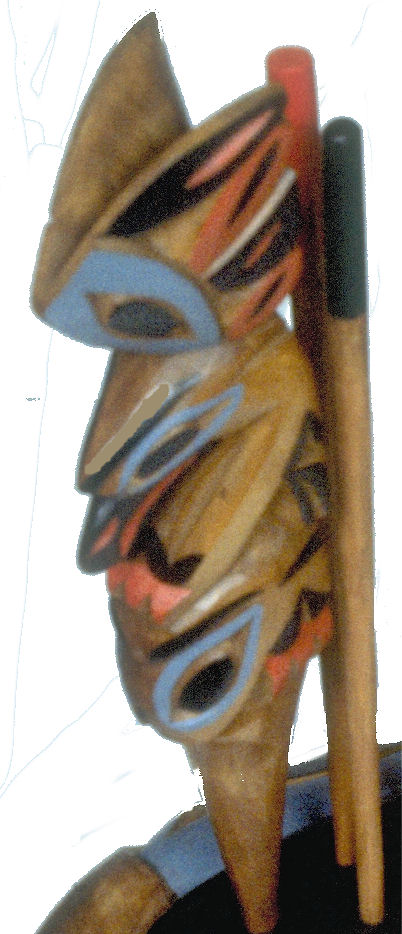
This visually impressive Pacific Northwest Coast Indian game has its origins lost in time since the game is not unlike dice games that were already old in ancient Rome or ancient China.
The colorful whale and sticks serve as a score keeping device. Play of the game is dependent upon two pieces of Antler which are used like dice. The game was made circa 1981 by Bill Kuhnely, Vancouver Island, British Columbia, Canada.

The game is for two players. The two pieces of Antler (photo on the right) are picked up by a player and thrown on a flat surface to earn points. (Note: A standard gambling die is a six sided cube which can result in numbers from 1 to 6; using two dice results in numbers 2 to 12.) A piece of Antler has 4 sides - a rounded side, a flat side, and two edges. The longer piece is 5.7cm long by 2.8cm in diameter. The shorter piece is 5.4cm. A leather thong is tied around the midsection of one piece of Antler (bottom piece in photo) to visually distinguish it from the other. Since the edges are not distinct, players may establish that a toss of the two pieces of Antler will result in these four combinations:
both landing on their flat sides
both landing on their rounded sides
one with thong on rounded side, other flat side
one with thong on flat side, other rounded side
Certain combinations of tosses must be made before earning sticks from the whale. The whale is carved from red cedar wood then painted with typical Pacific Northwest Coast Indian tribal designs. It is 55cm long x 17.5cm wide x 16.8cm high. On one side of the whale are eleven holes each housing a hardwood stick (29cm long x .8cm wide) tipped in red paint; opposite these are eleven holes each housing a similar hardwood stick tipped in black paint.

The blowhole of the whale holds a stylized totem pole (4.5cm wide x 33cm high) with a mythical animal at the base, a frog in the middle, and a thunderbird on top. This special blowhole stick is used in different ways depending upon the version of the game being played.
For those interested in finding more about the game, a general reference is:
Stewart Culin, Games of North American Indians, first published in 1906, now available as a reprint from Dover Books, New York, 1975, ISBN: 0486231259. The National Museums of Canada has issued a monograph of related interest: Gambling Music of Coast Salish Indians.
For those interested in finding more about Pacific Northwest Indian culture and the designs used on the whale, most encyclopedias carry such information - look up the Kwakiutl tribe of Potlatche fame which has been much studied by anthologists such as Franz Boaz.
This game was donated to the museum by the University of Waterloo's Recreation Students Association in 1984. It was purchased from Hill's Indian Crafts, 165 Water Street, Vancouver, British Columbia, V6B 1A7.
Last update July 4, 2010